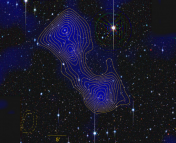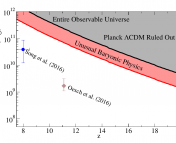Title: Cosmic web anisotropy is the primary indicator of halo assembly bias
Authors: Sujatha Ramakrishnan, Aseem Paranjape, Oliver Hahn, and Ravi K. Sheth
First Author’s Institution: Inter-University Centre for Astronomy & Astrophysics, Pune, India
Status: Submitted to MNRAS, open access on arXiV
Halos are biased
Dark matter halos make up the underlying structure of the universe. These halos, spherical-ish clouds of gravitationally bound dark matter, are connected by dark matter filaments. Together these make up a giant cosmic web.
It turns out that halos harbor a bias (no, not that kind of bias, but read about that too): they care about where they are situated in this greater environment. Specifically, the mass of the halo is related to the density (or “clustering”) of the cosmic web on much larger scales than the size of halo itself. This is because halos are formed by matter from these background densities collapsing, so larger halos will form in more dense environments.
Even at a fixed halo mass, the clustering depends on other “internal” halo properties. One of these is the concentration of the halo, which is illustrated in Figure 1 on a slice of a dark matter simulation. You can see visually that halos with higher concentration (red dots, left panel) cluster less strongly than halos with lower concentration (green dots, right panel). This effect is known as assembly bias.
Assembly bias also affects halo properties including their shape, spin, and the velocity distribution. Today’s paper introduces a new way of connecting all of these properties to the large-scale environment, via gravitational tides.

Figure 1: The effect of assembly bias in a dark matter simulation. Halos with high concentration (red dots, left panel) are less strongly clustered than halos with low concentration (green dots, right panel). The halos are shown overlaid on the same dark matter web slice in both panels. (Credit: Wechsler)
Turning the tide with tidal anisotropies
Halos are on the scale of ~100 kiloparsecs, which is a few times bigger than a typical galaxy. The large-scale environment has characteristic scales of ~10 Megaparsecs, a few times bigger than the average spacing between galaxies.
The authors of today’s paper ask: is there some mid-scale property that can connect the hundred-fold gap between these scales? They suggest that the tidal anisotropy around a halo might be just the thing. It is a measure of the local gravitational field that a halo sits in: a low anisotropy means a halo is equally gravitationally pulled in all directions (typically the case in low-density regions), while a high anisotropy indicates a halo is sitting near a massive object.
Think of halos as cities, and the cosmic web as the big interstates between them. To get from a city onto an interstate, you’ll first have to drive on some local highways, and just by looking at the flow of traffic on these highways, you could characterize the connection between cities and interstates fairly well. Tidal anisotropies are the local highways of the cosmos.
Correlations everywhere
To demonstrate this connection, the authors first show the correlation between various halo properties and the tidal anisotropy α. They analyze the halo ellipticity c/a, velocity ellipticity cv/av, velocity anisotropy β (related to both halo and velocity ellipticity), halo concentration cvir, and halo spin λ. The bias (dependence on large-scale environment) is denoted by b1.

Figure 2: Correlations between halo properties and the tidal anisotropy (α). All of the properties show a correlation or anti-correlation, indicating a connection between the internal happenings in the halo and its local gravitational environment. (Left panel of Figure 2 in the paper)
Figure 2 shows the correlation between these properties and the tidal anisotropy, as a function of halo mass. The Spearman rank correlation is a way of measuring how correlated two properties are (1 meaning completely correlated, -1 completely anti-correlated, and 0 no correlation). We see that all of the properties show a reasonably strong correlation (or anti-correlation) with the tidal anisotropy.
The left panel of Figure 3 shows the same statistic for halo bias, so we are now looking at the relationship between halo properties and large-scale environment. We also see correlations in all properties, though not as strong as with tidal anisotropy.

Figure 3: The y-axis is the Spearman rank correlation, as in Figure 2. The left panel shows the correlation between halo properties and large-scale bias (b1), which all have small but significant correlations. The right panel shows these correlations conditioned on the tidal anisotropy (α); the near-zero values mean that local anisotropy is a very good intermediary between halo properties and the large-scale environment. (Middle and right panels of Figure 2 in the paper)
Condition for silky smooth correlations
Conditioning is the most important step, as every cosm(et)ologist learns. To see how well the tidal anisotropy correlates with both the halo properties and the large-scale bias, the authors condition the bias-halo property correlations (middle panel) on the tidal anisotropy. This essentially divides out the relationship between the halo properties and the tidal anisotropy (left panel). If the bias and local anisotropy are closely related for a given halo property, this conditioning will leave you with zero.
The right panel of Figure 3 shows the result of this process. And behold, we see values close to zero! This indicates that the tidal anisotropy is a critical factor in driving halo assembly bias trends with internal properties.
This finding has practical consequences, including more accurately populating simulated halos with galaxies and understanding the related effect of galaxy bias. Look out for an incoming tide of papers utilizing the connection between tidal anisotropy and assembly bias!




